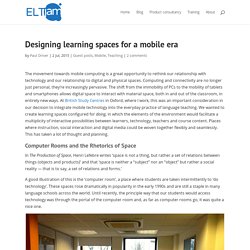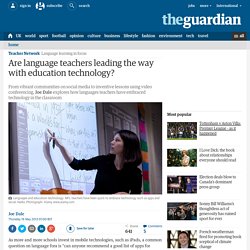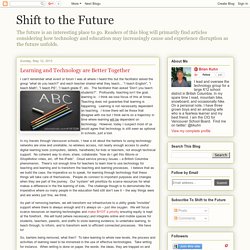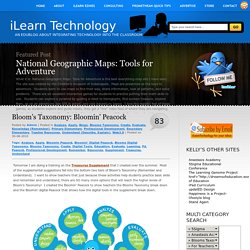

Technology does not equal innovation, but using technology is often crucial to innovation. – The Principal of Change. ‘Our Technology Is Our Ideology’: George Siemens on the Future of Digital Learning. What does it mean to be human in a digital age?

Designing learning spaces for a mobile era. The movement towards mobile computing is a great opportunity to rethink our relationship with technology and our relationship to digital and physical spaces.

Computing and connectivity are no longer just personal, they’re increasingly pervasive. The shift from the immobility of PCs to the mobility of tablets and smartphones allows digital space to interact with material space, both in and out of the classroom, in entirely new ways. At British Study Centres in Oxford, where I work, this was an important consideration in our decision to integrate mobile technology into the everyday practice of language teaching. We wanted to create learning spaces configured for doing, in which the elements of the environment would facilitate a multiplicity of interactive possibilities between learners, technology, teachers and course content.
Diverse Approaches to Developing and Implementing Competency based ICT Training for Teachers A Case Study KFIT2. Beginners' guide to using technology in language lessons. Blogging This is a fantastic way for pupils to share and celebrate their learning but a blog does need an audience to keep it alive for pupils.

A teacher can set up a class blog with individual student pages and it is incredibly easy to do and manage and allows the pupils chance to write exclusively in the language they have been learning. As the teacher you will probably need to populate the blog with articles to get the ball rolling and the pupils engaged but once they get the hang of it not only will they be leaving comments but also writing their own posts too. The British Council has a simple guide for setting up a class blog. Digital education — Schools firms starting to integrate tablet technology into classrooms. Digital education — Schools, firms starting to integrate tablet technology into classrooms By Associated Press Writer JOHNS CREEK — Time is up for the 13 students in Stephanee Stephens’ eighth-grade Spanish class.

For the last few minutes they’ve been conjugating verbs, each typing away on a small tablet when a message pops up on the screen: “Eyes on the Teacher.” Stephens, with tablet in hand, asks for “voluntarios o victimas” to come up front, plug their tablet into a projector and share their answers. This is the classroom of the future. Are language teachers leading the way with education technology? As more and more schools invest in mobile technologies, such as iPads, a common question on language fora is "can anyone recommend a good list of apps for language learning?

" My typical response is to suggest a range of generic apps for creating multimedia content (audio, video, animation, ebooks, cartoons and so on) which promote productive skills of speaking and writing, higher-order thinking and that allow pupils to publish the results to a real audience. Researching good apps and web tools takes time and keeping up to date with the latest innovations in educational technology is not a priority for some.
For others, using authentic materials or web tools is an essential part of their practice to make their lessons as relevant and pedagogically purposeful as possible. The 'MFLtwitterati' – a grassroots community of UK-based modern foreign language teachers on Twitter – has proved to be an invaluable testbed for ideas on using new technologies. Assessment and ICT. Learning and Technology are Better Together. I can’t remember what event or forum I was at where I heard this but the facilitator asked the group “what do you teach?”

And each teacher shared what they teach… “I teach English”, “I teach Math”, “I teach PE”, “I teach grade 5”, etc. The facilitator than asked “Don’t you teach students?”. Profoundly, teaching isn’t the goal, learning is. I think we lose focus of this at times. In my travels through Vancouver schools, I hear a lot about the barriers to using technology: networks are slow and unreliable, no wireless access, not nearly enough access to useful digital learning tools (computers, tablets, handhelds) for kids or teachers, not enough technical support. Flickr%2520-%2520langwitches%2520-%2520media%2520fluency%2520-%25205603703139%255B4%255D.jpg (image) The Four Stages Of The Self-Directed Learning Model.
Four Stages Of A Self-Directed Learning Model by TeachThought Staff Self-Directed Learning is not new, but is perhaps misunderstood.

Studied in terms of adult education and vocation for years, self-directed learning is increasing in popularity for a variety of reasons, including growing dissatisfaction with public schooling, and the rich formal and informal learning materials available online. This is the “age of information” after all. Self-directed learning is one response, something slideshare user Barbara Stokes captures in this chart, based on the model by Gerald Grow. The four stages–very similar to the gradual release of responsibility model–appear below. The Four Stages Of The Self-Directed Learning Model Learner Teacher Stage 1 Dependent Authority, Coach Stage 2: Interested Motivator, Guide Stage 3: Involved Facilitator Stage 4: Self-Directed Consultant, Delegator.
Theories of Teaching and Learning: The Staged Self-Directed Learnin... Evaluating Learner Autonomy: A Dynamic Model with Descriptors. Maria Giovanna Tassinari, Freie Universität Berlin, Germany Tassinari, M.

G. (2012). Evaluating learner autonomy: A dynamic model with descriptors. Studies in Self-Access Learning Journal, 3(1), 24-40. Download paginated PDF version Abstract. Canvas by Instructure. A Web 2.0 Class. Christopher Columbus was wrong when he reported to the King and Queen that the world is round. In fact, the world is flat and so are many of our classrooms in this great nation. For years, students learned within the parameters of a building, which then separated them into rooms. Students would attend class daily and the teacher would present the daily lesson. This is how a school day has progressed for years. And in many US classrooms, it still does. Students in Van Meter, Iowa, Burlington, Massachusetts, and Philadelphia, Pennsylvania are experiencing education in a new room. A Flat Classroom.
Elluminate. Edmodo. Bloom’s Taxonomy: Bloomin’ Peacock. Tomorrow I am doing a training on the Treasures Supplement that I created over the summer.

Most of the supplemental suggestions fall into the bottom two tiers of Bloom’s Taxonomy (Remember and Understand). I want to show teachers that just because these activities help students practice basic skills and remember and understand, there are SO many more options that will reach the higher levels of Bloom’s Taxonomy! I created the Bloomin’ Peacock to show teachers the Blooms Taxonomy break down and the Bloomin’ digital Peacock that shows how the digital tools in the supplement break down. Below are the tools listed in my Bloomin’ Digital Peacock Bloomin' Digital Peacock Remember: E-Learning Social.